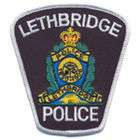Lethbridge Regional Police Service
| Lethbridge Regional Police Service | |
|---|---|
|
Logo of the Lethbridge Regional Police Service | |
| Motto | Providing Safe Communities |
| Agency overview | |
| Formed | 1 February, 2004 |
| Legal personality | Governmental: Government agency |
| Jurisdictional structure | |
| Legal jurisdiction | Regional |
| General nature |
|
| Operational structure | |
| Sworn members | 163 |
| Unsworn members |
50 Volunteer = 48 |
| Elected officer responsible | The Honourable Jonathan Denis, Minister of Justice and Solicitor General |
| Agency executive | Robert A. Davis, Chief of Police |
| Facilities | |
| Stations | 1 |
| Website | |
| Official website | |
Lethbridge Regional Police Service was established 1 February 2004 when the police services of Lethbridge and Coaldale, Alberta, amalgamated. The service covers Lethbridge and Coaldale.
History
The Lethbridge Police Force was established in 1902 with a staff of two and served a population of about 2,000. Thomas "the just" Lewis was appointed the Chief of Police. In 2009, the police service employed 155 officers, 47 civilian staff and over 40 civilian volunteers, and served a population of 92,435.
Lethbridge Regional Police Commission
The service is governed by a nine-person commission composed of three members of the Lethbridge City Council and the Coaldale town council and six citizens. The commission oversees the service, allocates funds from both councils and establishes policing policies. They provide instruction to the police chief regarding sufficient staffing levels.
Organization
The head of the service is Chief Tom McKenzie, who has over 30 years of policing experience with the service. The executive officers heading the service's four divisions are Inspector Tom Ascroft, Inspector Colin Catonio, Inspector Jeff Cove, and Inspector Bill Kaye.
Rank
The rank structure consists of the following:
- Chief
- Deputy Chief
- Inspector
- Staff sergeant
- Sergeant
- Senior constable
- Constable
Training
As of 2005, newly hired officers must complete the Police Recruit Training Program through the Centre for Advancement in Community Justice, located at the Lethbridge College.
Structure
The organization of the police service includes four divisions: community policing, criminal investigation, administrative support and support services.
Community policing
The community policing division maintains peace and good order, protects lives and property, and prevents and detects crime. It accomplishes this through the following:
- Patrol services
- Downtown policing
- Traffic safety
- Court liaison
- Community resources
- Victim and witness services
Criminal investigation
The criminal investigation division provides support services to on-going investigations through the major and organized crimes sections. Key areas of the division include the following:
- Violent crimes
- Forensic identification
- Crime analysis
- Property crimes
- Serious habitual offenders
- Special operations
- Criminal intelligence
- Economic crimes
- National weapons enforcement
- Gaming
Administrative support
The administrative support division oversees the following areas:
- Human resources
- Professional standards
- Policy and accreditation
- Property and exhibits
- Business management
Support services
The support services division provides support to all other divisions as required, including a specialized response to ongoing crises and ensuring the continuous flow of information. This division is responsible for:
- Public safety communications
- Information technology
- Records management
- Tactical support
Fleet
The majority of marked patrol vehicles deployed by the service are Ford Crown Victoria police interceptors. Some other marked vehicles are a Dodge Durango and a Ford Econoline van. Patrol vehicles contain the traditional black-and-white paint scheme.1 Dodge Charger Police package patrol car and 1 Ford Police interceptior were also added to the fleet in early 2013.
In 2012, the Lethbridge Regional Police Service added two Victory Commander I police motorcycles to its fleet. This followed a 20-year absence of motorcycles in the fleet.
- 2006–2008 Business Plan, Lethbridge Regional Police Service. Accessed 15 August 2006.
Officers carry SIG Sauer P226 pistols in .40 S&W as standard sidearm.
See also
External links
the fleet has also added 2 dodge charger police package interceptors to the fleet
